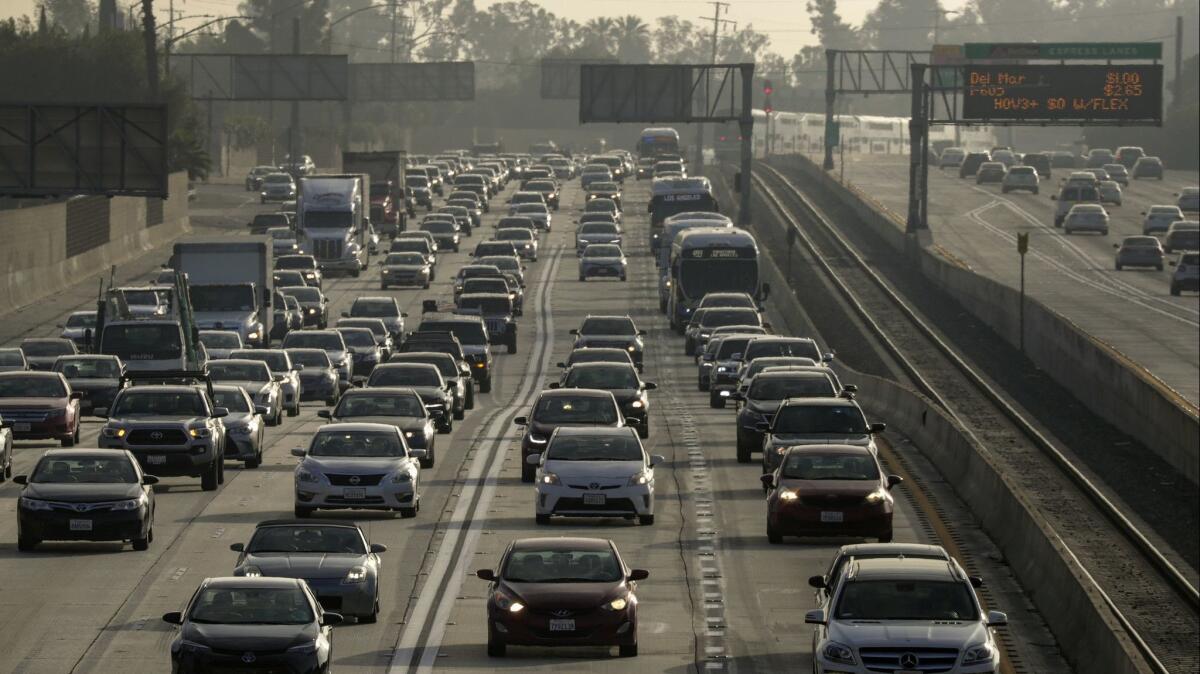Commuters who drive alone in zero-emission cars will no longer get free trips in L.A.’s toll lanes

- Share via
In a bid to reduce congestion in toll lanes on the 110 and 10 freeways, Los Angeles County transportation officials on Thursday opted to end a program granting solo drivers of zero-emission vehicles free access to the lanes.
Drivers with state-issued clean-air stickers will be charged a toll starting in November or December of this year, Metropolitan Transportation Authority officials said. They will receive a 15% discount on the per-mile toll lane price.
Clean-air stickers will still grant solo drivers access to California’s carpool lanes. Drivers who carpool in zero-emission vehicles will remain exempt from the toll.
“You can still save that money,” said Los Angeles Mayor Eric Garcetti, who supported the policy change, in an interview with reporters. “Just carpool.”
Metro’s change to the toll policy has drawn some criticism from environmental advocates, who say saving time and money is a major reason that Los Angeles County residents buy zero-emission cars. Reducing emissions from transportation is critical to meeting the state’s air quality and climate goals.
Metro officials said the policy is necessary to keep speeds in the lanes above the federally mandated minimum of 45 mph during rush hour. When it comes to taming congestion, they say, a zero-emission car with one occupant is no different from any other vehicle.
Tolls on the Harbor Freeway and the San Bernardino Freeway fluctuate between 35 cents to $2 per mile during rush hour, based on how many drivers are in the paid lanes. Higher tolls are intended to deter some drivers, freeing up space and shortening drive times for those willing to pay. Under the previous policy, such incentives held no sway over drivers of zero-emission vehicles
“They contribute to the congestion, which increases the toll price for the toll-paying customers,” Executive Officer Shahrzad Amiri told directors at Metro’s downtown meeting Thursday.
The share of zero-emission vehicles in the lanes has doubled to 6% in the last two years, Metro said. The number of clean-air decals issued statewide by the Department of Motor Vehicles grew 44% between the end of 2016 and March 1, to more than 320,000.
Traffic in the northbound 110 toll lane would flow 13 mph faster during rush hour if the volume of drivers fell by 5%, Metro staff said.
“When you’re at or near capacity, the smallest changes can have a profound impact on performance,” said Robert Campbell, a Metro manager of transportation planning.
Currently, a zero-emission driver receives a toll waiver by indicating on the transponder device that three or more people are in the car.
Under the new policy, the driver would indicate single occupancy. The freeway’s computer and camera system will scan the license plate number, and apply a 15% discount if the car is registered in the state’s clean air system.
Officials said drivers should expect that California’s policies on clean-air vehicles and carpool access will continue to evolve. Previous policy shifts have barred solo drivers of certain early-model hybrids such as the Toyota Prius from the lanes.
Los Angeles County Supervisor Sheila Kuehl, the only official to vote against the plan, said the decision shows Metro isn’t prioritizing the environment.
“We ought to simply admit that we really want to convert this to a toll lane, and we don’t really care about clean air … that all of the things that we adopted HOV lanes for in the first place, we’d like to abandon,” Kuehl said.
She also cited a recent UCLA study that found the ability to drive alone in a carpool lane or a toll lane is the “single biggest incentive” for Californians to buy a zero-emission vehicle if they live within 10 miles of such a lane.
Other board members questioned whether Metro and Caltrans could alleviate congestion by changing other policies. Currently, any vehicle with two occupants counts as a carpool on the 110. During peak hours, the 10 has a three-person carpool requirement.
Duarte councilman and Metro director John Fasana requested a study on how to begin tolling all passenger vehicles in the El Monte Freeway toll lane and busway aside from vanpools and buses.
Los Angeles City Councilman Paul Krekorian said in many cases, two people in the same vehicle would not have driven separately otherwise, meaning they do not meet the traditional definition of a carpool.
“It feels good for us to say, ‘Yes, let’s encourage carpooling,’” Krekorian said. “But I believe that carpooling is largely mythical in Los Angeles.”
For more transportation news, follow @laura_nelson on Twitter.
UPDATES:
6:40 p.m.: This article was updated to include comment from Los Angeles County supervisor Sheila Kuehl and Los Angeles City Councilman Paul Krekorian.
This article was originally published at 2:15 p.m.
More to Read
Sign up for Essential California
The most important California stories and recommendations in your inbox every morning.
You may occasionally receive promotional content from the Los Angeles Times.














